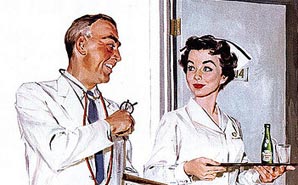



My father-in-law had a vision of the old-time horse and buggy doctor making house calls and taking medical care out to the people in the idyllic countryside.
Little did they know…
Back in the 1970s, most of our home health patients were card-carrying “frequent flyer club” members at the local hospital. The most common diagnoses were: Diabetes, hypertension, heart disease, sores that were treated with wet-to-dry dressings (the moist dressing standard was yet to come) and surgical wounds that had dehisced and/or become infected. The magical, marvelous wound vacuum systems had not yet been invented.
Instead of fancy mansions, most patients lived in mobile homes, housing projects or structures that could almost not be referred to as dwellings for humans. One patient lived in a converted tobacco barn that had one light bulb and a fireplace. A cat literally crawled through a hole in the back wall and birthed a litter of kittens.
Lack of indoor plumbing was still not uncommon in the country. In some cases, neighbors would share a well by running garden hoses across the yard or road to the next house or trailer. Sears still printed a catalog that was put to use in the outdoor loo.
Some of the older family doctors still accepted whatever the family could afford in lieu of payment: eggs, pecans or a side of beef, depending upon what was in season at the time. Nurses would bring in bags of squash, peaches, and onions to share with the rest of the office.
Directions to patients’ homes were very often dependent upon the location of dumpsters or old landmarks such as abandoned gas stations. (This was before 911 systems made it to the Deep South and all of the roads were given names.) There was no GPS to guide you and heaven help you if the county moved a dumpster!
We once had a patient who went to the hospital with what was finally diagnosed by the CDC as Rocky Mountain Spotted Fever. It was discovered that he lived in a tent just outside the city limits and had probably contracted the disease from a tick bite.
All of the paperwork was done by hand, in the pre-HIPPA era, and only two pages of documents were necessary for Medicare. This was BEFORE Congress “improved” things with the Federal Paperwork Reduction Act. Now we have 15 pages of OASIS to complete!
Today, I work for a small agency and we often get the cases that have been turned down by the “big dogs” in the home care industry. You know the ones: people with horrendous circumstances, no money or insurance and who don’t qualify for Medicare or Medicaid yet.
Sounds ancient, doesn’t it? But consider that this was only about 35 years ago!
 To Boldly Go… (Capt. James T. Kirk, USS Enterprise)
When we discuss students, we always mention their qualities. Those qualities show what they are…
If you or someone you know is juggling mental health issues alongside substance abuse, understanding…
For the last couple of weeks, the Israel-Hamas conflict has taken over the news cycle.…
Our eyes are invaluable, serving as our windows to the world. The ability to see…
Undoubtedly, one of the most demanding and challenging professions is nursing. Nurses work long hours in…
Echocardiography, or echo for short, is a key diagnostic test used by cardiologists to assess…